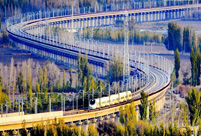

BEIJING, March 4 -- Two and a half years after President Xi Jinping proposed the Belt and Road Initiative, his home province of Shaanxi has become a major hub for this regional trade and infrastructure network and a frontier for China's opening to the outside world.
The northwestern province is "the new engine for west China and the new highland for China's inland areas. It's reaching out to Middle Asia, Europe and even Africa, through airlines, high-speed trains and cyberspace," said Fang Weifeng, director of the provincial economic planning body and one of the nearly 3,000 lawmakers in Beijing now for the annual session of the National People's Congress.
With economic development a heated topic at the session, Fang is rightly proud that Shaanxi's economy grew 8 percent last year, 1.1 percent higher than the national growth rate. And this year Shaanxi is aiming for 8-percent growth again, while the central government faces challenges in the process of economic restructuring and industrial upgrading.
Achieving all its economic goals set for the 2011-2015 period, Shaanxi has lifted itself from one of the country's least developed provinces to one of the most promising, according to the latest provincial work report.
One of the cradles of Chinese civilization, Shaanxi is the starting point of the ancient Silk Road to Rome, and home to the world-famous Terracotta Army. Its capital city Xi'an, over 1,000 km west of Beijing, now serves as a center for scientific research, aerospace industries and higher education.
"As the starting point of the new Silk Road and the core area for the Belt and Road Initiative, Shaanxi's opening up is in full swing," said Fang.
The Belt and Road, proposed by President Xi in 2013, refers to the Silk Road Economic Belt which links China with Europe through central and western Asia, and the 21st Century Maritime Silk Road connecting China with southeast Asia, Africa and Europe. In March last year, Chinese authorities published an action plan specifying its framework and priorities.
While still in its early stage, the initiative has paved the way for stronger connections and cooperation among dozens of countries and regions. It is supported financially by the Asian Infrastructure Investment Bank, which has an authorized capital of100 billion U.S. dollars, and the 40-billion-U.S.-dollar Silk Road Fund.
Shaanxi was an active player from the beginning. It held promotional exhibitions, expos and round table meetings for Silk Road countries, and launched joint schools, film festivals and art festivals.
Back in 2014, Shaanxi's Coal and Chemical Industry Group invested in building an oil refinery in Kyrgyzstan that is now the most advanced oil refinery in central Asia.
Shaanxi's total import and export volume exceeded 30 billion U.S. dollars last year, a year-on-year growth of 12.8 percent that ranked fifth nationwide. This year, it plans to build on the momentum of establishing a free trade zone and offshore Renminbi business center and push for more industrial cooperation with foreign firms.
"We must seize the moment," Fang said. "The Belt and Road Initiative has come at the right time and is leading world economic development. China needs it and so do many other countries."
 China has world's largest high-speed rail network
China has world's largest high-speed rail network Top beauties in Chinese provinces
Top beauties in Chinese provinces 600 people attend Lusheng playing contest in S China
600 people attend Lusheng playing contest in S China Engineer troop builds bridge in real combat conditions
Engineer troop builds bridge in real combat conditions You can urinate in public in Chongqing
You can urinate in public in Chongqing Rice terrace scenery in southwest China's Yunnan
Rice terrace scenery in southwest China's Yunnan 2016 Miss Chinatown USA pageant held in San Francisco
2016 Miss Chinatown USA pageant held in San Francisco Ancient pagodas across China
Ancient pagodas across China Wedding dress show up in the air
Wedding dress show up in the air Top 20 hottest women in the world in 2014
Top 20 hottest women in the world in 2014 Top 10 hardest languages to learn
Top 10 hardest languages to learn 10 Chinese female stars with most beautiful faces
10 Chinese female stars with most beautiful faces China’s Top 10 Unique Bridges, Highways and Roads
China’s Top 10 Unique Bridges, Highways and Roads Foreign investment in SOEs welcome: MOFCOM
Foreign investment in SOEs welcome: MOFCOM China adopts pop songs, rock to instill patriotism in youth
China adopts pop songs, rock to instill patriotism in youth No more ship-grounding tricks allowed in South China Sea
No more ship-grounding tricks allowed in South China Sea What it takes to be a real Beijing expat – according to the old hands themselves
What it takes to be a real Beijing expat – according to the old hands themselvesDay|Week